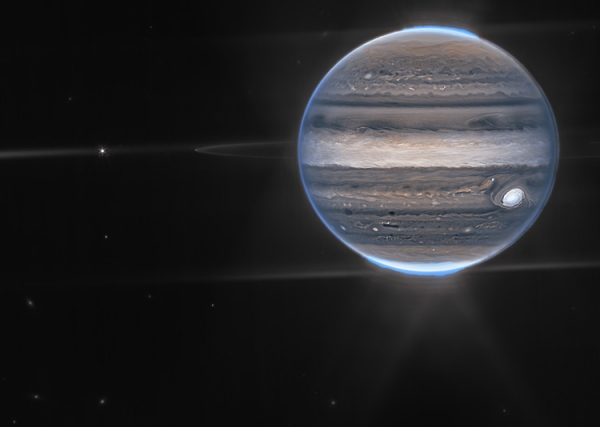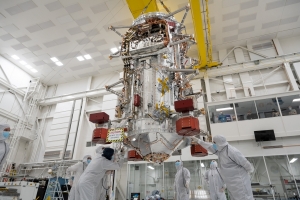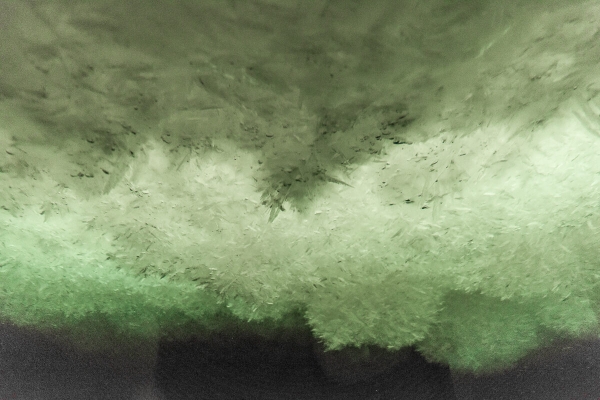The new Jupiter photos from JWST’s Near Infrared Camera (NIRCam) are unusual, enough so that I decided to fold one into today’s post. It’s a pretty good fit because I had already put together most of the material I was going to use about Europa. It would have been an additional plus if Europa showed up in the image below, but even without it, note that we can see moons as small as Adrasta here. Imke de Pater (UC-Berkeley), who led the observations, noted that both tiny satellites and distant galaxies show up in the same image. And here’s Thierry Fouchet, a professor at the Paris Observatory, who likewise worked on the observing effort:
“This image illustrates the sensitivity and dynamic range of JWST’s NIRCam instrument. It reveals the bright waves, swirls and vortices in Jupiter’s atmosphere and simultaneously captures the dark ring system, 1 million times fainter than the planet, as well as the moons Amalthea and Adrastea, which are roughly 200 and 20 kilometers across, respectively. This one image sums up the science of our Jupiter system program, which studies the dynamics and chemistry of Jupiter itself, its rings and its satellite system.”
And yes, these images are significantly processed, in this case by citizen scientist Judy Schmidt in California and Ricardo Hueso (University of the Basque Country, Spain). Hurdo is a co-investigator on the Early Release Science program and also leads the NIRCam observations of Jupiter’s Atmosphere. I think Schmidt, who has been working with space observations for a decade, says it best when she describes her goal as “to get it to look natural, even if it’s not anything close to what your eye can see.”

Image: This false-color composite image of Jupiter was obtained July 27 with the NIRCam instrument on board the JWST. Jupiter’s faint rings — a million times dimmer than the planet — and two of its small satellites, Amalthea (left) and Adrastea (dot at edge of ring), are clearly visible against a background of distant galaxies. The diffraction pattern created by the bright auroras and the moon Io (to the left out of the image), form a complex background of scattered light around Jupiter. (Image credit: NASA, European Space Agency, Jupiter Early Release Science team. Image processing: Ricardo Hueso [UPV/EHU] and Judy Schmidt).
I had this image on-screen this morning as I looked into progress on Europa Clipper, which is in the midst of its most significant year so far. By the end of 2022, most flight hardware and all the science instruments are expected to be installed at the Jet Propulsion Laboratory’s Spacecraft Assembly Facility. Engineers and technicians will be assembling the spacecraft’s main body in the installation’s High Bay 1. That includes installation of the craft’s science instruments as well as the aluminum electronics vault that shields the electronics from Jupiter’s radiation. Launch is currently scheduled for October, 2024. We should get nearly 50 close passes of Europa out of all this.

Image: Engineers and technicians use a crane to lift the core of NASA’s Europa Clipper spacecraft in the High Bay 1 clean room of JPL’s Spacecraft Assembly Facility. Credit: NASA/JPL-Caltech.
Watching a spacecraft come together is a fascinating exercise, and we’ll keep an eye on NASA’s updates on the Clipper as the process continues. Just as fascinating, though, is the continual inflow of information about what Europa Clipper’s science instruments will be looking for, a process just as critical if we are to interpret its data correctly.
On that score, what an interesting paper has recently turned up in Astrobiology. In the hands of lead author Natalie Wolfenbarger, it comes out of the University of Texas at Austin, where Europa Clipper’s radar instrument has been developed. A key issue is the composition of the moon’s ice shell, which in turn will feed our conclusions about the ocean lying beneath. Europa’s ocean has been likened to the waters beneath an Antarctic ice shelf on Earth. A good comparison?
To find out, Wolfenbarger and colleagues went to work on how water freezes under ice shelves, which takes us into two unusual terms. ‘Congelation ice’ forms under the ice shelf, while ‘frazil ice’ floats upward in the form of ice flakes in supercooled seawater. These form a kind of snow that coats the bottom of the ice shelf. Interestingly, both ice production mechanisms produce ice with less salinity than seawater itself.
In other words, we may have been assuming that Europa’s ocean is saltier than it actually is, particularly given the paper’s finding that scaling up what happens under Antarctica to an ice shell the size and age of Europa’s produces ice that is less salty still. Frazil ice in particular retains only a small fraction of seawater salt, and the authors make the case that it should be common on Europa. A less saline ice shell is significant because salinity governs its strength and the movement of heat through it.

Image: Mounds of snow-like ice under an ice shelf. Credit: ©Helen Glazer 2015 from the project Walking in Antarctica.
Thus we use our own planet as a research model to understand mechanisms likely at play on a Jovian moon, in ways that help us prepare for Europa Clipper’s look via its ice penetrating instrument, which is called REASON (Radar for Europa Assessment and Sounding: Ocean to Near-surface). This is the only one of the spacecraft’s nine instruments that can look directly into the ice shell, a process that we have experience with on Earth, as REASON principal investigator Don Blankenship notes: “We’ve used ice-penetrating radar for decades. That’s how we know Earth’s ice sheets’ thickness.”
The thickness of the ice is important for everything from getting future probes through the shell into the ocean beneath to creating conditions for an ocean with more likelihood of habitable conditions. For Europa is constantly bathed in particles flung against its surface by Jupiter’s magnetic field, so that compounds emerge that would be useful to life below. A thinner ice sheet would make it more likely that these compounds enter the ocean. No wonder the thickness of the ice has been such a contentious matter among scientists, whose estimates range from a few kilometers to tens of kilometers thick.
Europa Clipper’s REASON instrument uses different wavelengths of radio waves and will be capable of penetrating the ice shell as much as 30 kilometers. This should get interesting.
The paper is Wolfenbarger et al., “Ice Shell Structure and Composition of Ocean Worlds: Insights from Accreted Ice on Earth,” Astrobiology Vol. 22, No. 8 (25 July 2022). Abstract.



It seems the ice crust may be formed by 2 processes. The first is from the upwelling subsurface ocean that geysers onto the surface and depositions the saline water around the plume. The second is an accretion of ice from below which should thicken the crust before the surface loses.
If so, then we should expect the instruments to show that the surface salinity is variable, with the higher levels around the plumes and cracks in the ice crust. If there are organics, then these should be similarly concentrated in the second region. Fluorescence might just be able to detect the differences.
What would be interesting is to know the relative impacts of the 2 crust building mechanisms. If the crust thickness is in a steady state, then if the accretion from below is dominant, there must be losses from the surface, perhaps by spalling from Jupiter’s radiation. OTOH, if the plumes and upwelling are dominant, then the bottom of the crust must be being melted, perhaps by pressure (even at low gravity, the crust thickness must be exerting more pressure at the ice-ocean interface than in the Arctic sea ice). Is it possible that both are operating in a way that we cannot assume a steady state and that the crust is thickening over time?
While not testable any time soon, if the ice is accumulating from below, this implies to me that there will be a time record in the ice. Would it be a record of changing conditions, and just possibly contain a record of prebiotic chemistry and even life itself? Unlike the surface, where radiation and meteorite gardening of the surface disrupts any detailed record of the past, the bottom of the crust may preserve a pristine record of conditions over time.
I am disappointed that Clipper is not tasked with getting through the ice by drilling and/or melting. About the same level of disappointment about the multiplicity of Mars rovers, all of which have not been equipped for the direct detection of life.
Paul Gilster covered the drilling idea recently: https://centauri-dreams.org/2022/07/01/drilling-into-icy-moon-oceans/ A take-home point is that it would probably have to go ten times further than anyone has ever drilled into ice on Earth! Not impossible… not easy. Of course, the geology could be more interesting and variable than we can imagine, but if we’re hoping for luck, it’s best to have a rover that drives around long distances until it spots a cryovolcanic vent releasing liquid water.
Hi Mike, but if the rover did see a vent releasing water, NASA would immediately drive as far away as possible to avoid contaminating the site.
Don’t underestimate the terrain any vehicle would need to traverse to get to such a vent. There are all types of ice formations that would making it impossible: a simple adaption of a Mars rover to Europa would not get far, if anywhere at all. Not to underestimate the geography of a vent: don’t expect a waterfall oasis but a deep chasm or crack possibly several km’s deep.
The vents are only usable when flying over them until the terrain around such a vent is mapped at human scale.
Icy Moons, And Exploring The Secrets They Hold
AUGUST 18, 2022
MARC KAUFMAN
https://manyworlds.space/2022/08/18/icy-moons-and-exploring-the-secrets-they-hold/
” …Interestingly, both ice production mechanisms produce ice with less salinity than seawater itself.
In other words, we may have been assuming that Europa’s ocean is saltier than it actually is, particularly given the paper’s finding that scaling up what happens under Antarctica to an ice shell the size and age of Europa’s produces ice that is less salty still. Frazil ice in particular retains only a small fraction of seawater salt, … ”
I thought most ice frozen from sea water was mostly fresh water; not true ?
Yes.
However, I think the 2 processes indicated – congelation and crystalization below the surface are not the same process as the formation of sea ice.
The congelation process seems to be a freezing of the saltwater in direct contact with the underside of the ice crust, and it seems the salts are not fully ejected, but remain in the lattice. The frazil ice seems to be more like the creation of sea ice.
So I would say that we would expect both ice formation processes should be less salty than the surrounding seawater, but that the congelation process is not as effective at removing the salts.
What I am not clear in my mind is why the subsurface ocean might be less salty than previously believed.
“So I would say that we would expect both ice formation processes should be less salty than the surrounding seawater, but that the congelation process is not as effective at removing the salts.”
” …congelation process is not as effective at removing the salts.”
almost certainly due to freezing under high water pressure…
Solubility of solids and gases in liquid in relation to temperature.
Loss of solute from liquids on freezing.
What happens to the solute when a solution freezes?
If you were to freeze the solution in a normal manner, using something similar to a home freezer, a more and more concentrated solution will form as the majority of the solvent freezes. The solute will be found in a small amount of solution that did not freeze, since the solute allows for freezing point depression. So, if you put both of your beakers into the freezer, one beaker will have a completely frozen block of solvent and the other will have a frozen block of solvent with some volume of highly concentrated solution.
This is the process for freeze “distillation” of spirits. The alcohol-water mixture becomes more concentrated as the water freezes out. Sometimes used in cold climates. The problem is that any methanol and other toxic and undesirable molecules will not be removed either. Any mash will have to be filtered off too.
Nothing we haven’t seen before
Any potential impactors threatening? Maybe a sub-probe could follow it down.
A very interesting idea, although I have read that the ice would freeze over almost immediately after an impact. Can this be confirmed?
My other question is, are any astronomers actually monitoring for such an event at Jupiter?
Impact events on Jupiter
New announcement of a possible water world at only 100ly. Tess discovery TOI1452 b. It’s nearness makes it an interesting object for study. But at 5 Earth masses, and 30%! water by mass its ocean floor will be sealed by km thick high pressure ice phases. Despite this it is still labeled as a “Super Earth” which lay folk will interpret as “Earth-like”. I fervently wish this silly term be banned to the dustbin of history.
https://exoplanets.nasa.gov/news/1710/discovery-alert-intriguing-new-super-earth-could-get-a-closer-look/
I agree, ‘Terrestrial type of planet’ might be a better term to use.